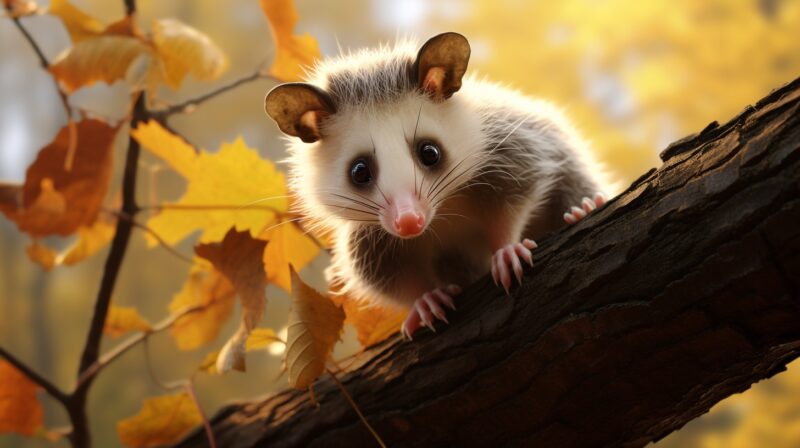Opossums, often noticed for their unique behavior of playing dead, are fascinating creatures that are a common sight in many parts of the world. However, what often goes unnoticed is their notably short lifespan.
Today, we will explore the reasons behind the rapid aging and early mortality of opossums, offering insights into their biology, lifestyle, and the environmental factors that contribute to this phenomenon.
The Opossum Lifespan
Opossums, particularly the common North American species, have a naturally short lifespan. In the wild, they live for only about two to three years.
This brief lifespan is partly due to their rapid maturation. Opossums are capable of reproducing at a very young age, sometimes as early as six months old.
This early maturity is a biological adaptation that allows them to propagate their species quickly, a necessary trait for animals with a high predation rate.
Genetic Factors and Aging
Genetic makeup plays a significant role in the opossum’s short lifespan. Unlike humans and some other mammals, they do not have a wide array of genetic adaptations to counteract the aging process.
Their bodies are less efficient at repairing cellular damage, which leads to quicker aging and a higher susceptibility to diseases typically associated with old age.
Environmental Pressures and Survival Strategies
The environment in which opossums live also contributes to their short lives.
As opportunistic feeders, they often inhabit areas close to human populations where food is plentiful, but so are risks like traffic and predators.
Their survival strategy does not emphasize longevity but rather focuses on rapid reproduction to maintain population numbers.
The Harsh Reality
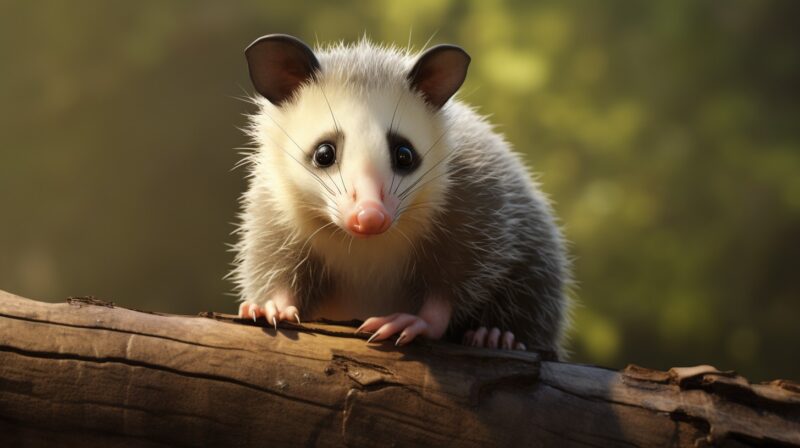
Predation is a significant factor in the short lifespan of opossums. As small to medium-sized mammals, they fall prey to larger animals such as coyotes, foxes, and owls.
Additionally, their scavenging lifestyle exposes them to various diseases, which their immune systems are often not equipped to handle effectively.
The Impact of Human Activities
Human activities have a profound effect on the lifespan of opossums. Urbanization leads to loss of habitat and increases in encounters with vehicles, both of which are detrimental to their survival.
Moreover, human-induced environmental changes can disrupt the delicate balance of ecosystems, affecting the availability of food and safe nesting areas for opossums.
The Role of Stress and Lifestyle
Stress, resulting from constant exposure to predators and human activity, also contributes to their short lifespan.
Chronic stress can lead to a weakened immune system, making opossums more susceptible to diseases.
Additionally, as nocturnal animals, their natural rhythms can be disrupted by urban lighting and noise, further impacting their health and longevity.
The Biology
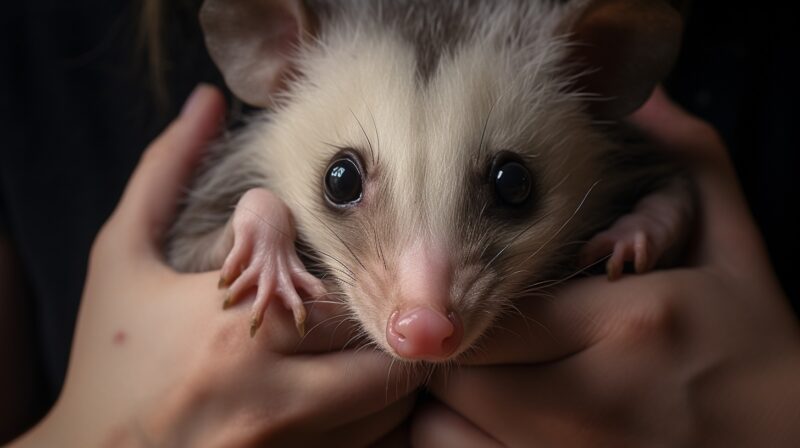
Opossums possess several unique physical traits, such as their prehensile tails and opposable thumbs on their hind feet, which aid in climbing and foraging.
Behaviorally, they are known for “playing dead,” a defense mechanism used to deter predators.
The Reproductive Strategy
Reproduction plays a vital role in the life of an opossum. Females can give birth to multiple litters per year, each containing up to 20 babies.
This high reproductive rate is nature’s way of ensuring the continuation of the species despite individual opossums’ short lifespans.
Diet and Adaptability
Opossums are omnivores and highly adaptable in their diet, eating everything from fruits and insects to small animals and carrion.
This adaptability is crucial for their survival in varied environments but also exposes them to risks like ingesting contaminated food or human waste.
Conservation and Human Interaction
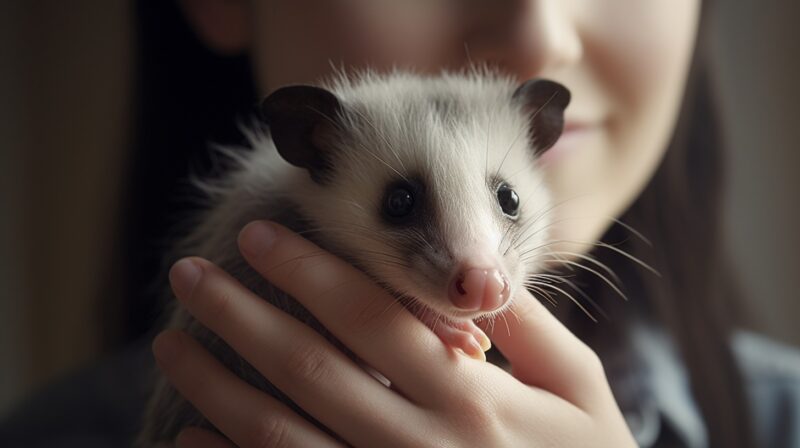
Opossums play a vital role in their ecosystems. They help control insect populations, including ticks, and their scavenging cleans up dead animals and organic waste.
Having knowledge about their short lifespan is crucial for conservation efforts, as it highlights the need to protect their habitats and reduce human-wildlife conflicts.
Efforts to Protect Opossums
Conservation efforts focus on habitat preservation and reducing risks from human activities.
Educational programs that inform the public about the beneficial role of opossums and how to coexist with them can significantly improve their chances of survival.
The future of opossums depends largely on human actions. By mitigating the impacts of urbanization and climate change and fostering a better knowledge and appreciation of these creatures, we can ensure a safer and more sustainable environment for opossums to thrive.
The Ecological Impact of Opossums
Opossums, with their diverse diet, play a crucial role in balancing ecosystems.
By consuming a wide range of insects, small rodents, and carrion, they help control pest populations and aid in the decomposition process.
This ecological service is vital for maintaining the health and stability of their habitats.
The Role of Opossums in Seed Dispersal
Opossums also contribute to seed dispersal. As they forage, seeds from the fruits they consume are spread across their territory, aiding in plant diversity and forest regeneration.
This aspect of their behavior is often overlooked but is essential for sustaining diverse plant life in their ecosystems.
Interaction with Other Wildlife
Opossums interact with various wildlife species, both as competitors and as prey. Their presence in an ecosystem can influence the population dynamics of other species, showcasing their integral role in the natural food chain.
Challenges in Opossum Conservation
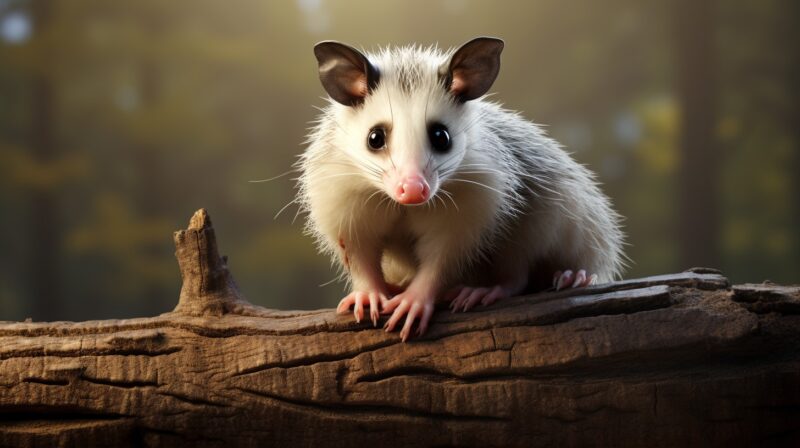
Habitat Loss and Fragmentation
One of the most significant challenges facing opossums is habitat loss and fragmentation due to urban development and agriculture.
This not only reduces their living space but also isolates populations, making it harder for them to find food, mates, and safe nesting areas.
Climate Change and Its Effects
Climate change poses a growing threat to opossum populations. Altered weather patterns can affect their food sources and habitat conditions, potentially leading to increased mortality rates and reduced reproductive success.
The Need for Targeted Conservation Efforts
Effective conservation strategies for opossums must address these challenges. Protecting natural habitats, creating wildlife corridors, and implementing climate-resilient conservation practices are essential steps in ensuring their survival.
Human Perceptions and Their Impact on Opossums
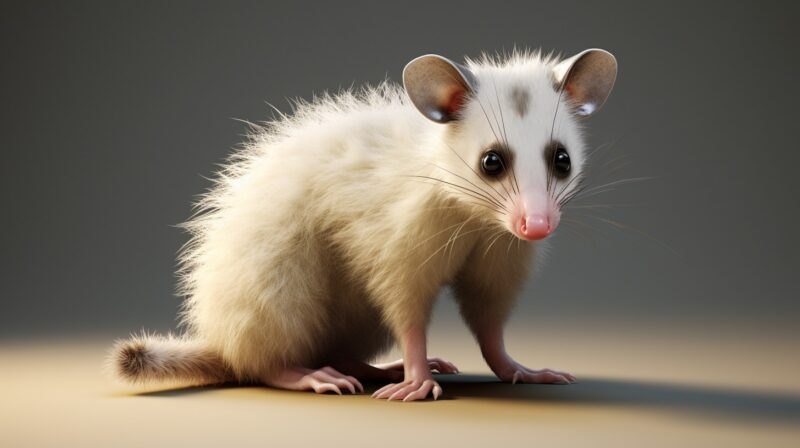
Opossums often suffer from a negative public image, seen as pests or dangerous animals. These misconceptions can lead to mistreatment and disregard for their well-being.
Educating the public about the true nature and benefits of opossums is critical in changing these perceptions.
The Benefits of Coexisting with Opossums
Learning to coexist with opossums can have numerous benefits. For instance, their role in controlling tick populations can help in reducing the spread of Lyme disease.
Embracing their presence can lead to a healthier and more balanced urban and suburban wildlife ecosystem.
Wildlife Rehabilitation and Rescue Efforts
Wildlife rehabilitation and rescue organizations play a significant role in protecting and caring for injured or orphaned opossums.
Supporting these organizations and their work is a practical way to contribute to the conservation of this species.
FAQs
Can opossums adapt to different climates and environments?
Yes, they are highly adaptable and can thrive in various environments, including forests, urban areas, and near water sources.
Their adaptability extends to different climates, though they predominantly favor temperate regions.
Do opossums have any natural defenses against predators?
Besides playing dead, they have sharp teeth and can deliver a painful bite when threatened.
Their ability to climb and their nocturnal nature also serve as natural defenses against predators.
Are opossums solitary or social animals?
They are mostly solitary animals, especially adults. They come together mainly during the mating season, and mothers care for their young until they are old enough to be independent.
How do opossums contribute to controlling tick populations?
They eat a significant number of ticks they encounter, significantly reducing tick populations in areas where they live. This feeding habit helps control tick-borne diseases in the environment.
Do opossums carry diseases that are harmful to humans or pets?
They are generally not carriers of rabies due to their low body temperature. However, they can carry other diseases like leptospirosis and can host fleas, which may transmit diseases to pets.
How can people help in conserving opossum populations?
People can help by protecting their natural habitats, driving cautiously in areas where they are known to live, and supporting local wildlife conservation initiatives.
Educating others about the ecological benefits of opossums also plays a crucial role in their conservation.
Final Words
The rapid aging and early demise of opossums are the result of a complex interplay of biological, environmental, and human factors.
Their short lifespan is a reflection of a life strategy focused on quick maturity and reproduction, set against the backdrop of a challenging and often hostile world.
Knowing these factors not only sheds light on the intriguing life of these marsupials but also underscores the importance of our role in their conservation.
Related Posts:
- How Fast Can A Black Bear Run? Surprising Swiftness Revealed
- Are Opossums Dangerous to Humans? Unmasking the Truth!
- How Do Opossums Survive Winter? Discover Their…
- What Sounds Do Opossums Make? - Identify and…
- Are Opossums Dangerous to Pets? - How to Deal With Them
- Why Are Dolphins Mammals? - The Aquatic Mystique


